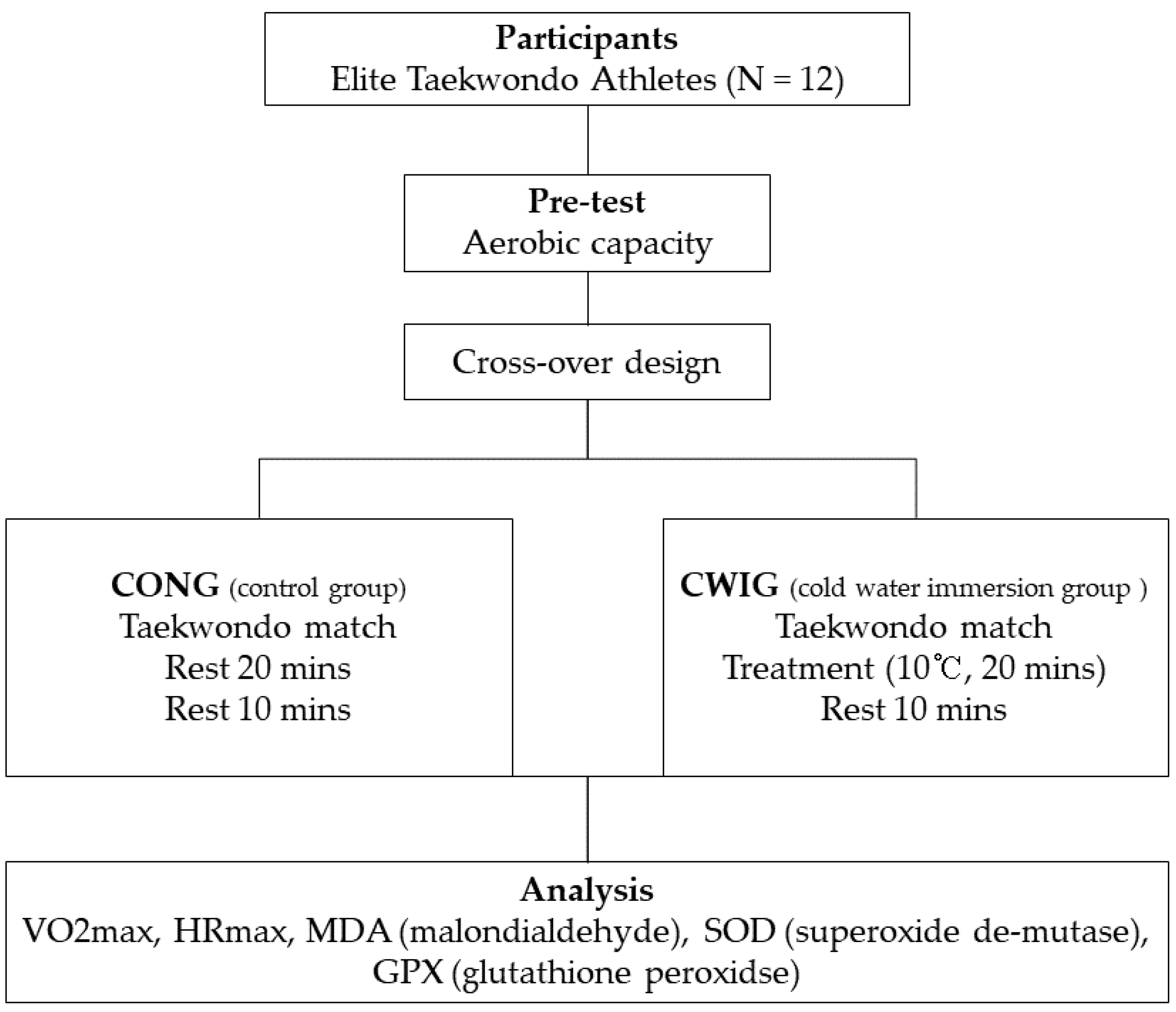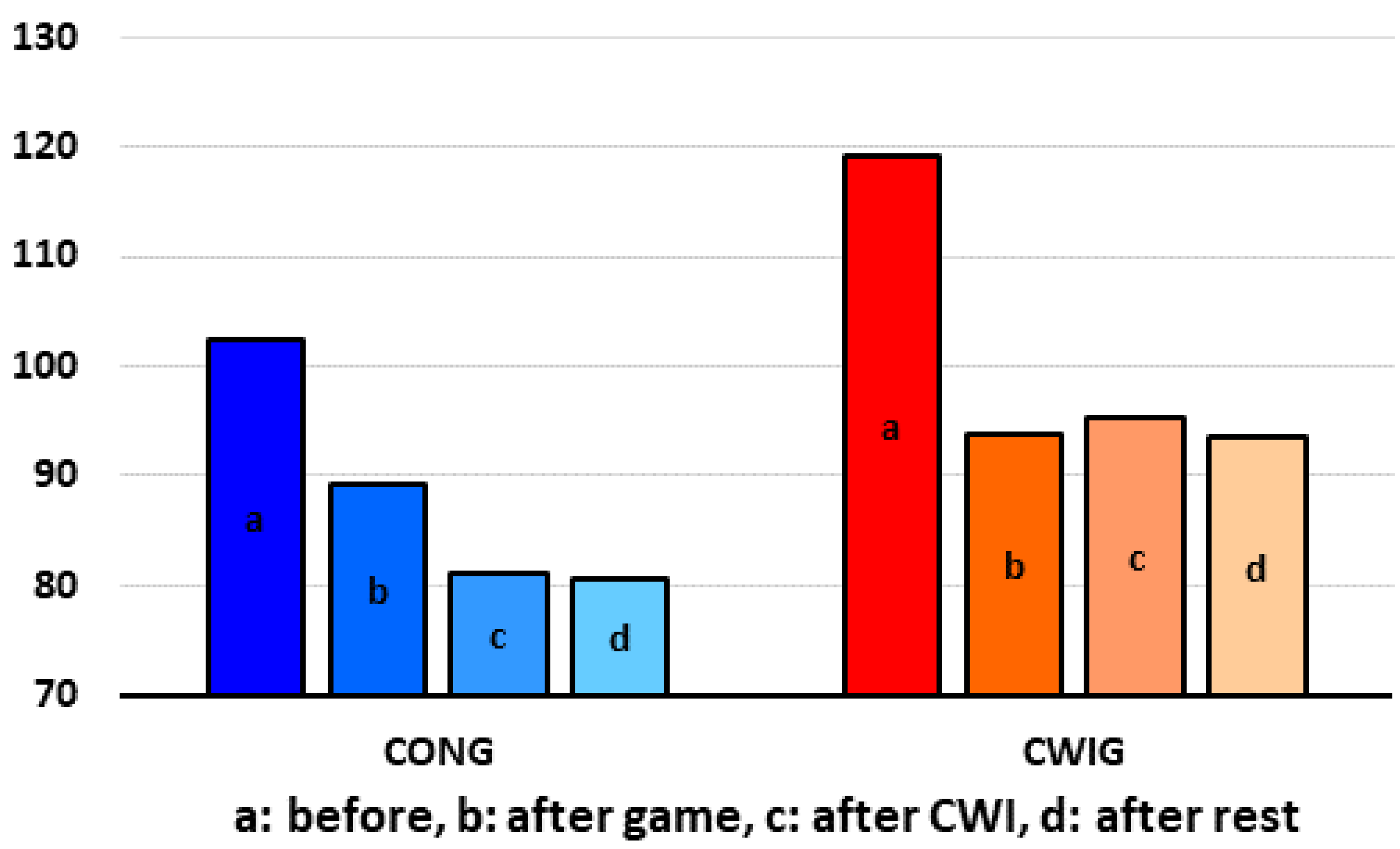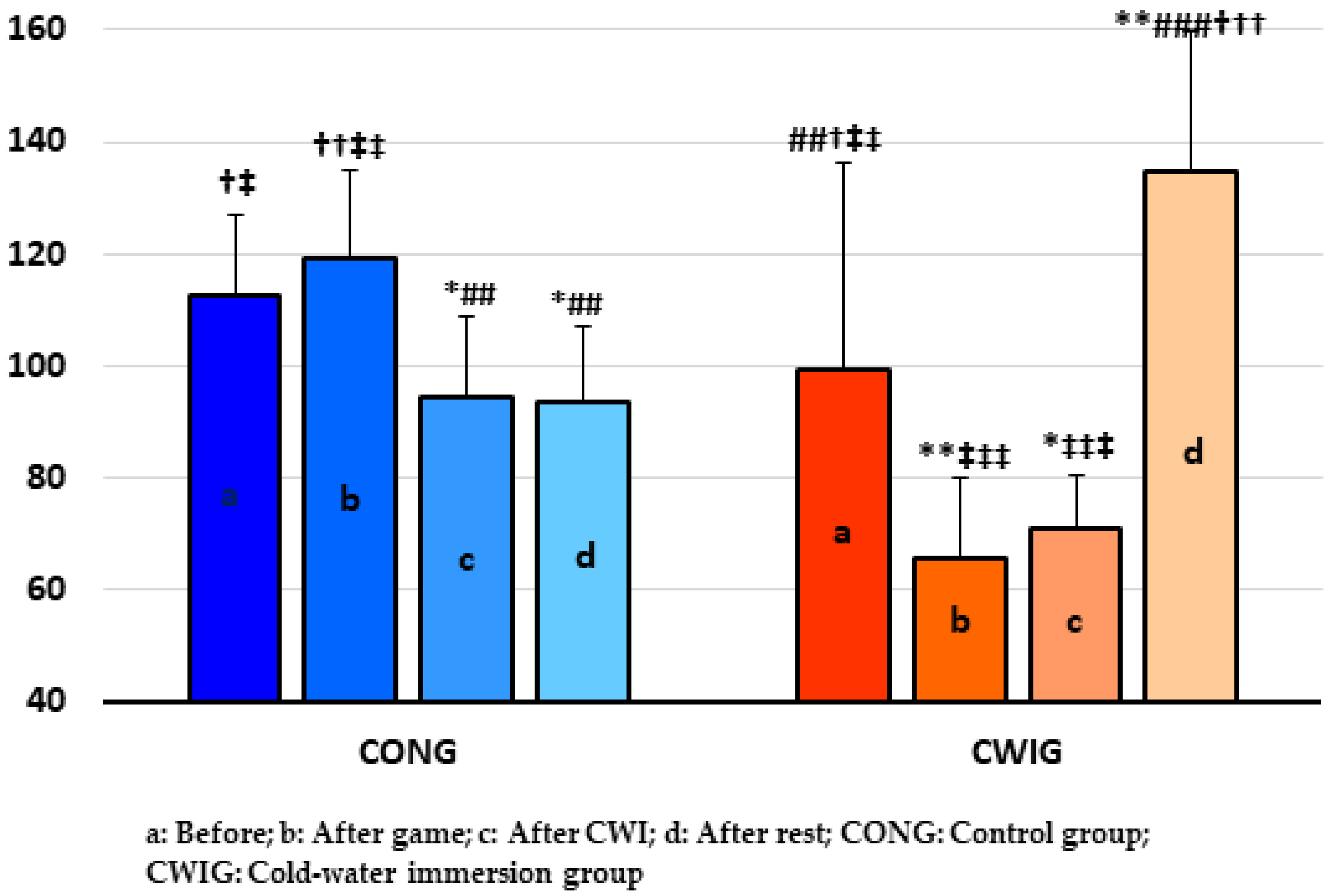Cold-Water Immersion Promotes Antioxidant Enzyme Activation in Elite Taekwondo Athletes
Abstract
1. Introduction
2. Materials and Methods
2.1. Participants
2.2. Experimental Design
2.3. Taekwondo Competition
2.4. Treatment Methods-CWI
2.5. Blood Analysis
2.6. Statistical Analysis
3. Results
3.1. Intensity during Taekwondo Competition
3.2. Change in MDA Concentration
3.3. Change in SOD Concentration
3.4. Change in GPX Concentration
4. Discussion
4.1. Athletic Intensity of the Taekwondo Competition
4.2. Variation of MDA Concentration after CWI for Taekwondo Athletes
4.3. Variation of Antioxidant Enzyme Concentration According to CWI for Elite Taekwondo Athletes
4.4. Limitations of the Study
5. Conclusions
Author Contributions
Funding
Institutional Review Board Statement
Informed Consent Statement
Data Availability Statement
Acknowledgments
Conflicts of Interest
References
- Niess, A.M.; Sommer, M.; Schneider, M.; Angres, C.; Tschositsch, K.; Golly, I.C.; Fehrenbach, E. Physical exercise-induced expression of inducible nitric oxide synthase and heme oxygenase-1 in human leukocytes: Effects of RRR-α-tocopherol supplementation. Antioxid. Redox Signal. 2000, 2, 113–126. [Google Scholar] [CrossRef]
- Fernández-Lázaro, D.; Mielgo-Ayuso, J.; Seco Calvo, J.; Córdova Martínez, A.; Caballero García, A.; Fernandez-Lazaro, C.I. Modulation of exercise-induced muscle damage, inflammation, and oxidative markers by curcumin supplementation in a physically active population: A systematic review. Nutrients 2020, 12, 501. [Google Scholar] [CrossRef]
- Halliwell, B. Free radicals, antioxidants, and human diseases: Curiosity, cause, or consequence? Lancet 1994, 344, 721–724. [Google Scholar] [CrossRef]
- Jones, J.I.; Clemmons, D.R. Insulin-like growth factors and their binding proteins: Biological actions. Endocr. Rev. 1995, 16, 3–34. [Google Scholar] [PubMed]
- Ji, L.L. Antioxidant enzyme response to exercise and aging. Med. Sci. Sports Exerc. 1993, 25, 225–231. [Google Scholar] [CrossRef] [PubMed]
- Jenkins, R.R.; Goldfarb, A. Introduction: Oxidant stress, aging and exercise. Med. Sci. Sports Exerc. 1993, 25, 210–212. [Google Scholar] [CrossRef] [PubMed]
- Reznick, A.Z.; Steinhagan-Thiessen, E.; Gershon, D. The effect of exercise on enzymes activities in cardiac muscle of mice of various ages. Biochem. Med. 1992, 28, 347–352. [Google Scholar] [CrossRef]
- Holloszy, J.O.; Booth, F.W. Biochemical adaptations to endurance exercise in muscle. Ann. Rev. Physiol. 1976, 38, 273–291. [Google Scholar] [CrossRef]
- Slattery, K.; Bentley, D.; Coutts, A.J. The role of oxidative, inflammatory and neuroendocrinological systems during exercise stress in athletes: Implications of antioxidant supplementation on physiological adaptation during intensified physical training. Sports Med. 2015, 45, 453–471. [Google Scholar] [CrossRef]
- Andriichuk, A.; Tkachenko, H.; Tkachova, I. Oxidative stress biomarkers and erythrocytes hemolysis in well-trained equine athletes before and after exercise. J. Equine Vet. Sci. 2016, 36, 32–43. [Google Scholar] [CrossRef]
- Bailey, D.M.; Erith, S.J.; Griffin, P.J.; Dowson, A.; Brewer, D.S.; Gant, N.; Williams, C. Influence of cold-water immersion on indices of muscle damage following prolonged intermittent shuttle running. J. Sport Sci. 2007, 25, 1163–1170. [Google Scholar] [CrossRef]
- Vaile, J.; Halson, S.; Gill, N.; Dawson, B. Effect of cold water immersion on repeat cycling performance and thermoregulation in the heat. J. Sport Sci. 2008, 26, 431–440. [Google Scholar] [CrossRef] [PubMed]
- Delextrat, A.; Calleja-Gonzάlez, J.; Hippocrate, A.; Clarke, N.D. Effects of sports massage and intermittent cold-water immersion on recovery from matches by basketball players. J. Sport Sci. 2013, 31, 11–19. [Google Scholar] [CrossRef]
- Rowsell, G.J.; Coutts, A.J.; Reaburn, P.; Hill-Haas, S. Effects of cold-water immersion on physical performance between successive matches in high-performance junior male soccer players. J. Sport Sci. 2009, 27, 565–573. [Google Scholar] [CrossRef]
- Ascensão, A.; Leite, M.; Rebelo, A.N.; Magalhäes, S.; Magalhäes, J. Effects of cold water immersion on the recovery of physical performance and muscle damage following a one-off soccer match. J. Sport Sci. 2011, 29, 217–225. [Google Scholar] [CrossRef] [PubMed]
- Racinais, S.; Oksa, J. Temperature and neuromuscular function. Scand. J. Med. Sci. Sports 2010, 20, 1–18. [Google Scholar] [CrossRef] [PubMed]
- Stocks, J.M.; Taylor, N.A.S.; Tipton, M.J.; Greenleaf, J.E. Human physiological responses to cold exposure. Sport Aviat. Space Environ. Med. 2004, 75, 444–457. [Google Scholar]
- Siems, W.G.; Brenke, R.; Sommerburg, O.; Grune, T. Improved antioxidative protection in winter swimmers. QJM 1999, 92, 193–198. [Google Scholar] [CrossRef] [PubMed]
- Wozniak, A.; Mila-Kierzenkowska, C.; Szpinda, M.; Chwalbinska-Moneta, J.; Augustynska, B.; Jurecka, A. Whole-body cryostimulation and oxidative stress in rowers: The preliminary results. Arch. Med. Sci. 2013, 9, 303. [Google Scholar] [CrossRef] [PubMed]
- Lee Kyung, K.T.; Choi, Y.S.; Lee, Y.K.; Lee, J.P.; Young, K.W.; Park, S.Y. Extensor hallucis longus tendon Injury in Taekwondo Athletes. Phys. Ther. Sport 2009, 10, 101–104. [Google Scholar]
- Kim, Y.J.; Cha, E.J.; Kim, S.M.; Kang, K.D.; Han, D.H. The effects of Taekwondo training on brain connectivity and body intelligence. Psychiatry Investig. 2015, 12, 335–340. [Google Scholar] [CrossRef] [PubMed]
- Pieter, W.; Zemper, E.D. Incidence of reported cerebral concussion in adult Taekwondo athletes. Perspect. Public Health 1998, 118, 272–279. [Google Scholar] [CrossRef] [PubMed]
- Pieter, W.; Zemper. E.D. Head and neck injuries in young Taekwondo athletes. J. Sport Med. Phys. Fit. 1999, 38, 147–153. [Google Scholar]
- Kasemi, M.; Pieter, W. Injuries at a Canadian national Taekwondo championships: A prospective study. BMC Musculoskel. Disord. 2004, 5, 22. [Google Scholar] [CrossRef] [PubMed]
- Bøyum, A.; Wiik, P.; Gustavsson, E.; Veiby, O.P.; Reseland, J.; Haugen, A.H.; Opstad, P.K. The effect of strenuous exercise, calorie deficiency and sleep deprivation on white blood cells, plasma immunoglobulins and cytokines. Scand. J. Immunol. 1996, 43, 228–235. [Google Scholar] [CrossRef] [PubMed]
- Kanter, M.M.; Nolte, L.A.; Holloszy, J.O. Effects of an antioxidant vitamin mixture on lipid peroxidation at rest and postexercise. J. Appl. Physiol. 1993, 74, 965–969. [Google Scholar] [CrossRef]
- Beis, K.; Pieter, W.; Abatzides, G. Taekwondo techniques and competition characteristics involved time-loss injuries. J. Sport Sci. Med. 2007, 6, 45–51. [Google Scholar]
- Pieter, W.; Paul, G.F.; Michael, D.O. Competition injuries in Taekwondo: A literature review and suggestions for prevention and surveillance. Br. J. Sport Med. 2012, 46, 485–491. [Google Scholar] [CrossRef]
- Kazemi, M.; Judith, W.; Morgan, C.; White, A.R. A profile of Olympic Taekwondo competitors. J. Sport Sci. Med. 2006, 5, 114–121. [Google Scholar]
- De Pauw, K.; De Geus, B.; Roelands, B.; Lauwens, F.; Verschueren, J.; Heyman, E.; Meeusen, R.R. Effect of five different recovery methods on repeated cycle performance. Med. Sci. Sport Exerc. 2011, 43, 890–897. [Google Scholar] [CrossRef]
- Schniepp, J.; Campbell, T.S.; Powell, K.L.; Pincivero, D.M. The effects of cold-water immersion on power output and heart rate in elite cyclists. J. Strength Cond. Res. 2002, 16, 561–566. [Google Scholar]
- Crowe, M.J.; O’Connor, D.; Rudd, D. Cold water recovery reduces anaerobic performance. Int. J. Sport Med. 2007, 28, 994–998. [Google Scholar] [CrossRef] [PubMed]
- Pieter, W.; Bercades, L.T.; Kim, G.D. Relative total body fat and skinfold patterning in Filipino national combat sport athletes. J. Sport Sci. Med. 2006, 5, 35–41. [Google Scholar]
- Bouhlel, E.; Jouini, A.; Gmada, N.; Nefzi, A.; Ben Abdallah, K.; Tabka, Z. Heart rate and blood lactate responses during Taekwondo training and competition. Braz. J. Biomotricity 2006, 21, 285–290. [Google Scholar] [CrossRef]
- Markovic, G.; Vucetic, V.; Cardinale, M. Heart rate and lactate responses to Taekwondo fight in elite women performers. Bio Sport 2008, 25, 135–146. [Google Scholar]
- Cools, A.M.; Geerooms, E.; Dorien, F.M.; Berghe, V.D.; Cambier, D.C.; Witvrouw, E. Isokinetic scapular muscle performance in young elite gymnasts. J. Athl. Train. 2007, 42, 458–563. [Google Scholar] [PubMed]
- Fritzsche, J.; Raschka, C. Body composition and somatotype of German top Taekwondo practitioners. Paper Anthropol. 2008, 17, 58. [Google Scholar]
- Butios, S.; Tasika, N. Changes in heart rate and blood lactate concentration as intensity parameters during simulated Taekwondo competition. J. Sport Med. Phys. Fit. 2007, 47, 179–185. [Google Scholar]
- Pieter, W.; Taaffe, D.; Heijmans, J. Heart rate response to Taekwondo forms and technique combinations. A pilot study. J. Sport Med. Phys. Fit. 1990, 30, 97–102. [Google Scholar]
- Bride, C.A.; Jones, M.A.; Drust, B. Physiological responses and perceived exertion during international Taekwondo competition. Int. J. Sport Physiol. Perform. 2009, 4, 485–493. [Google Scholar] [CrossRef]
- Quash, G.; Ripoll, H.; Gazzolo, L.; Doutheau, A.; Saba, A.; Gore, J. Malondialdehyde production from spermine by homog-enates of nomal and transformed cells. Biochimie 1987, 69, 101–108. [Google Scholar] [CrossRef]
- Clanton, T.L.; Zuo, L.; Klawitter, P. Oxidants and skeletal muscle function: Physiologic and pathophysiologic implications. Proc. Soc. Exp. Biol. Med. 1999, 222, 253–262. [Google Scholar] [CrossRef] [PubMed]
- Sutkowy, P.; Woźniak, A.; Boraczyński, T.; Mila-Kierzenkowska, C.; Boraczyński, M. Postexercise impact of ice-cold water bath on the oxidant-antioxidant balance in healthy men. BioMed. Res. Int. 2015, 2015, 706141. [Google Scholar] [CrossRef] [PubMed]
- Lubkowska, A.; Dołęgowska, B.; Szyguła, Z.; Bryczkowska, I.; Stańczyk-Dunaj, M.; Sałata, D.; Budkowska, M. Win-ter-swimming as a building-up body resistance factor inducing adaptive changes in the oxidant/antioxidant status. Scand. J. Clin. Lab. Investig. 2013, 38, 315–325. [Google Scholar] [CrossRef] [PubMed]
- Merrick, M.A.; Jutte, L.S.; Smith, M.E. Cold modalities with different thermodynamic properties produce different surface and intramuscular temperatures. J. Athl. Train. 2003, 38, 28–33. [Google Scholar]
- Krishnan, R.K.; Evans, W.J.; Kirwan, J.P. Impaired substrate oxidation in healthy elderly men after eccentric exercise. J. App. Physiol. 2003, 94, 716–723. [Google Scholar] [CrossRef][Green Version]
- Ortenblad, N.; Madsen, K.; Djurhuus, M.S. Antioxidant status and lipid peroxidation after short-term maximal exercise in trained and untrained humans. Am. J. Physiol. Regul. 1997, 272, 1258–1263. [Google Scholar] [CrossRef]
- Ji, L.L. Exercise-induced modulation of antioxidant defense. Ann. N. Y. Acad. Sci. 2002, 959, 82–92. [Google Scholar] [CrossRef]
- Child, R.B.; Wilkinson, D.M.; Fallowfield, J.L. Effects of a training taper on tissue damage indices, serum antioxidant capacity and half-marathon running performance. Int. J. Sports Med. 2000, 21, 325–331. [Google Scholar] [CrossRef]
- Chiodo, S.; Tessitore, A.; Cortis, C.; Cibelli, G.; Lupo, C.; Ammendolia, A.; De Rosas, M.; Capranica, L. Stress-related hormonal and psychological changes to official youth Taekwondo competition. Scand. J. Med. Sci. Sports 2011, 21, 111–119. [Google Scholar] [CrossRef]
- Tsai, M.L.; Chou, K.M.; Chang, C.K.; Fang, S.H. Changes of mucosal immunity and antioxidation activity in Elite Male Taiwanese taekwondo athletes associated with intensive training and rapid weight loss. Br. J. Sport Med. 2011, 45, 729–734. [Google Scholar] [CrossRef] [PubMed]
- Iaia, F.M.; Perez-Gomez, J.; Nordsborg, N.; Bangsbo, J. Effect of previous exhaustive exercise on metabolism and fatigue development during intense exercise in humans. Scand. J. Med. Sci. Sports 2010, 20, 619–629. [Google Scholar] [CrossRef]
- Ravier, G.; Dugué, B.; Grappe, F.; Rouillon, J.D. Maximal accumulated oxygen deficit and blood responses of ammonia, lactate and PH after anaerobic test: A comparison between international and national elite karate athletes. Int. J. Sport Med. 2006, 27, 810–817. [Google Scholar] [CrossRef] [PubMed]
- Halson, S.L.; Jeukendrup, A.E. Does overtraining exist? Sport Med. 2004, 34, 967–981. [Google Scholar] [CrossRef] [PubMed]
- Peternelj, T.-T.; Coombes, J.S. Antioxidant supplementation during exercise training. Sport Med. 2011, 41, 1043–1069. [Google Scholar] [CrossRef] [PubMed]
- Swenson, C.; Swärd, L.; Karlsson, J. Cryotherapy in sports medicine. Scand. J. Med. Sci. Sports 1996, 6, 193–200. [Google Scholar] [CrossRef]
- Bleakley, C.M.; Bieuzen, F.; Davison, G.W.; Costello, J.T. Whole-body cryotherapy: Empirical evidence and theoretical perspectives. Open Access J. Sports Med. 2014, 5, 25. [Google Scholar] [CrossRef]
- Miller, E.; Markiewicz, Ł.; Saluk, J.; Majsterek, I. Effect of short-term cryostimulation on antioxidative status and its clinical applications in humans. Eur. J. Appl. Physiol. 2012, 112, 1645–1652. [Google Scholar] [CrossRef] [PubMed]
- Siems, W.G.; van Kuijk, F.J.; Maass, R.; Brenke, R. Uric acid and glutathione levels during short-term whole body cold exposure. Free Radic. Biol. Med. 1994, 16, 299–305. [Google Scholar] [CrossRef]
- Wozniak, A.; Wozniak, B.; Drewa, G.; Mila-kierzenkowska, C. The effect of whole-body cryostimulation on the prooxidant–antioxidant balance in blood of elite kayakers after training. Eur. J. Appl. Physiol. 2007, 101, 533–537. [Google Scholar] [CrossRef]
- Rakowski, A.; Jurecka, A.; Rajewski, R. Whole-body cryostimulation in kayaker women: A study of the effect of cryogenic temperatures on oxidative stress after the exercise. J. Sport Med. Phys. Fit. 2009, 49, 201–207. [Google Scholar]





| t | p | |
|---|---|---|
| Before | 0.370 | 0.715 |
| Between round 1 | 1.786 | 0.088 |
| After round 1 | 1.108 | 0.320 |
| Between round 2 | 0.362 | 0.720 |
| After round 2 | 0.502 | 0.621 |
| Between round 3 | 0.167 | 0.869 |
| After round 3 | 0.413 | 0.684 |
| Group | CONG | CWIG | F | |||
|---|---|---|---|---|---|---|
| Time | ||||||
| Pre-match | 102.5 ± 23.00 | 119.2 ± 27.61 | Group | 3.040 | ||
| Post-match | 89.3 ± 17.05 | 93.9 ± 31.04 | ||||
| Time | 8.864 *** | |||||
| Post-treatment | 81.0 ± 16.40 | 95.3 ± 26.59 | ||||
| Group × Time | 0.497 | |||||
| Post-rest | 80.7 ± 19.77 | 93.5 ± 19.88 | ||||
| Group | CONG | CWIG | F | |||
|---|---|---|---|---|---|---|
| Time | ||||||
| Pre-match | 1.7 ± 0.90 | 1.6 ± 1.02 | Group | 0.158 | ||
| Post-match | 3.0 ± 1.64 | 2.5 ± 1.52 | ||||
| Time | 8.496 *** | |||||
| Post-treatment | 2.0 ± 0.96 | 1.9 ± 1.08 | ||||
| Group × Time | 0.945 | |||||
| Post-rest | 1.8 ± 1.04 | 2.0 ± 1.31 | ||||
| Group | CONG | CWIG | F | |||
|---|---|---|---|---|---|---|
| Time | ||||||
| a Pre-match | 112.4 ± 14.37 cd | 99.2 ± 37.30 bcd | Group | 6.778 * | ||
| b Post-match | 119.1 ± 15.84 cd | 65.7 ± 14.35 ad | ||||
| Time | 13.317 *** | |||||
| c Post-treatment | 94.3 ± 14.38 ab | 70.8 ± 9.78 ad | ||||
| Group × Time | 26.588 *** | |||||
| d Post-rest | 93.4 ± 13.74 ab | 134.7 ± 24.98 abc | ||||
Publisher’s Note: MDPI stays neutral with regard to jurisdictional claims in published maps and institutional affiliations. |
© 2021 by the authors. Licensee MDPI, Basel, Switzerland. This article is an open access article distributed under the terms and conditions of the Creative Commons Attribution (CC BY) license (http://creativecommons.org/licenses/by/4.0/).
Share and Cite
Park, E.-H.; Choi, S.-W.; Yang, Y.-K. Cold-Water Immersion Promotes Antioxidant Enzyme Activation in Elite Taekwondo Athletes. Appl. Sci. 2021, 11, 2855. https://doi.org/10.3390/app11062855
Park E-H, Choi S-W, Yang Y-K. Cold-Water Immersion Promotes Antioxidant Enzyme Activation in Elite Taekwondo Athletes. Applied Sciences. 2021; 11(6):2855. https://doi.org/10.3390/app11062855
Chicago/Turabian StylePark, Eun-Hee, Seung-Wook Choi, and Yoon-Kwon Yang. 2021. "Cold-Water Immersion Promotes Antioxidant Enzyme Activation in Elite Taekwondo Athletes" Applied Sciences 11, no. 6: 2855. https://doi.org/10.3390/app11062855
APA StylePark, E.-H., Choi, S.-W., & Yang, Y.-K. (2021). Cold-Water Immersion Promotes Antioxidant Enzyme Activation in Elite Taekwondo Athletes. Applied Sciences, 11(6), 2855. https://doi.org/10.3390/app11062855





